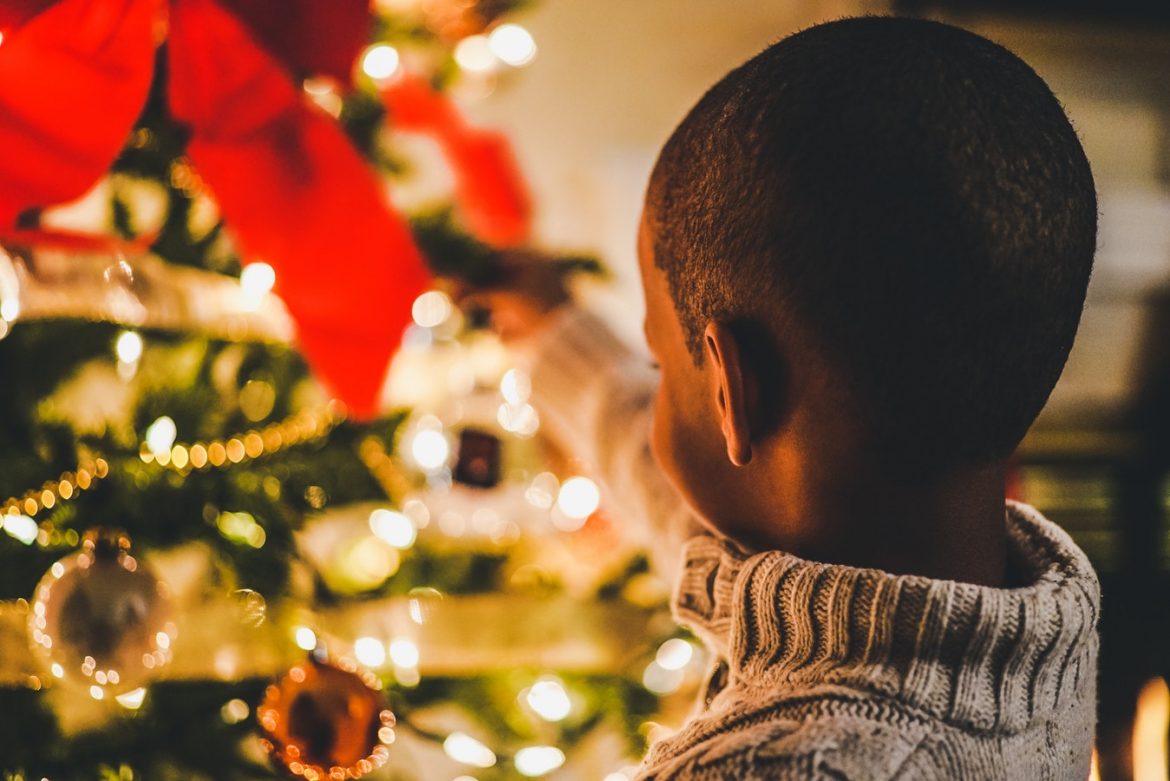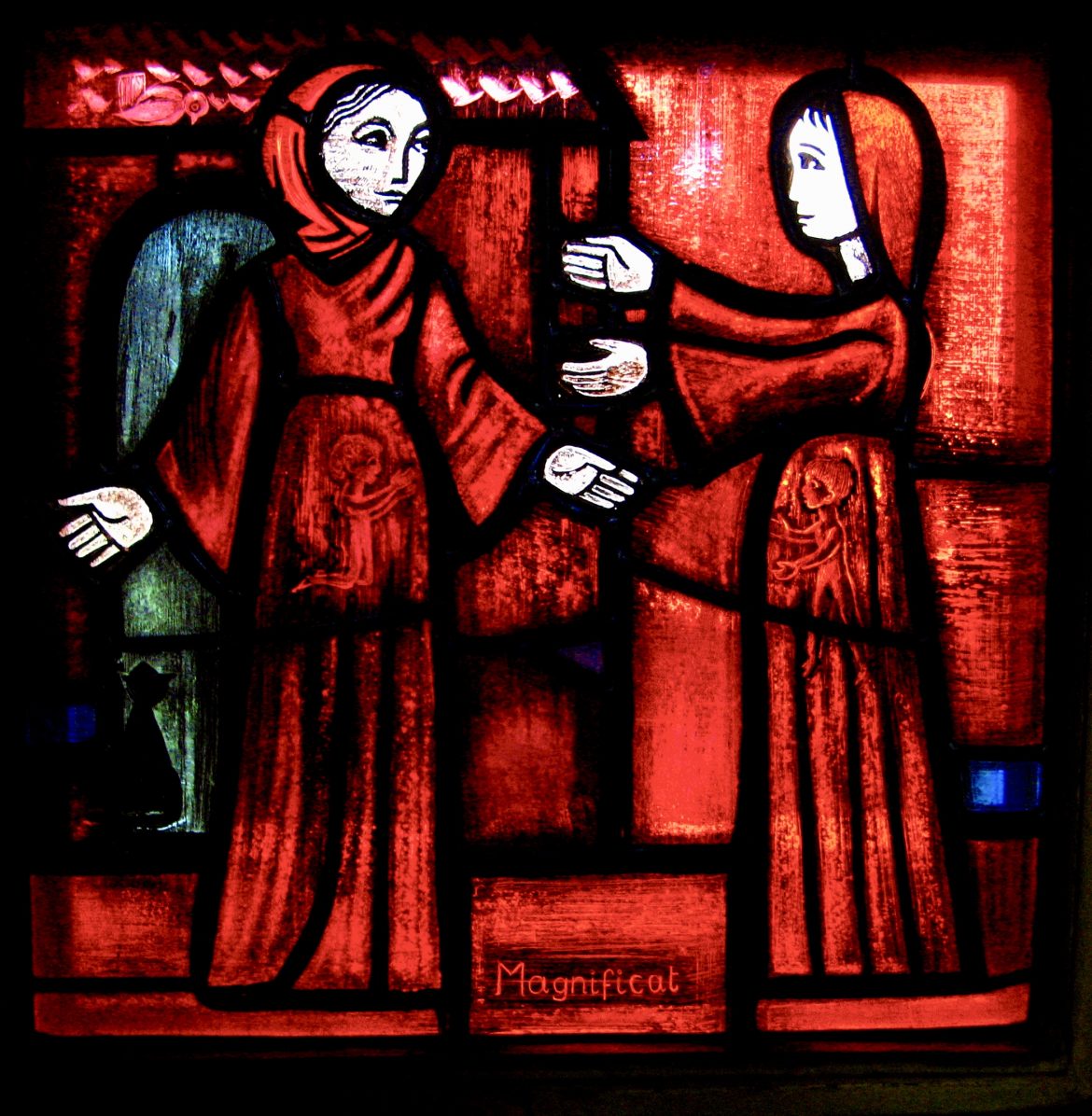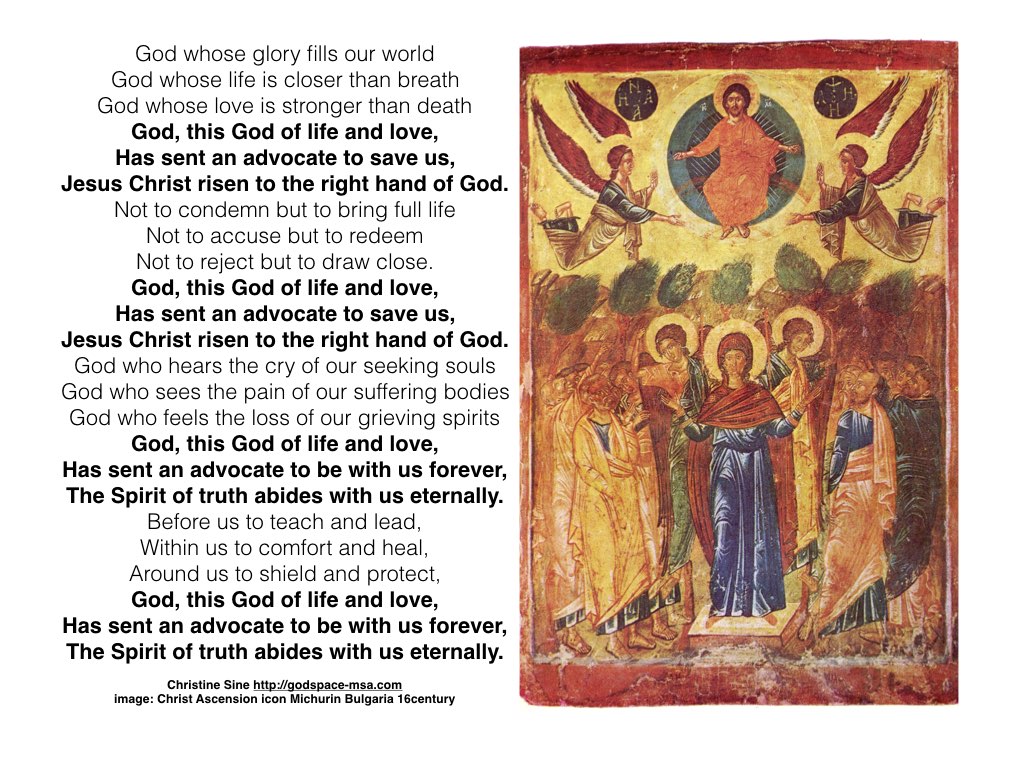During Advent, each week John Lewis will be providing a post with activities that you can do individually or together with your family. As you begin to prepare for the advent season, read this great post by John on how to make it meaningful —
Putting up lights or stockings, baking cookies, and wrapping presents may be JOY-FILLED traditions your family already practices. TRADITIONS can help connect these familiar practices and symbols of the Christmas story to your family’s heritage, values, faith and personality. Year after year, these require a higher degree of intentionality. While many of us may not have grown up with traditions like that, their BLESSINGS ae much worth the effort and planning! Where do we start? The most enduring FAITH traditions (Lord’s Supper, Baptism, Weddings) are practiced in community. So, we know that relying on others is a tried and true place to start. Carissa and I offer below not a formula but some steps that might help your family create and celebrate meaningful family CHRISTMAS traditions.
Step #1: Decide to do it
Let’s face it. There are many obstacles during the holidays that must be overcome to achieve meaningful and faith filled Christmas traditions: busyness, distraction, guilt, and added Christmas duties during the month. So:
- Gather your family to discuss the benefits of traditions together (family bonding and identity, passing down values and faith, etc.). If you decide together, you will set yourself up for success.
- Decide as parents and as a family that this is important. Declare that with God’s help, you will start some small but meaningful traditions. Ironically, the best time to start is when your kids are ‘2 or S, when you are still scrambling and the kids seem too young to understand much. They will pick up more than we realize.
- Pray for God’s help and commit this to God together. It’s not about you being responsible for their success!
Step #2: Start with brainstorming
- Identify any traditions for your families of origin that you want to continue or adapt (putting up the tree/lights, e.g.)? What does your family already love to do together during Christmas?
- Identify some family values, Christmas stories, and biblical themes you want to highlight this Christmas season (giving, serving, God as light, e.g.).
- Identify your family’s passions, practices, and personality. What do you already like to do? (love for baking, e.g.) These might contribute ideas to adapting old Christmas traditions or starting new ones.
Step #3: Find some resources
- Resources that identify the original story, legend, meaning behind the symbols and traditions of Christmas.
- Book or guide that you can use, learn from, or adapt for building meaningful long term traditions (I could not easily find one that I liked that would suit this purpose, so I did my own.)
- Ask for help from others who either already practice holiday traditions, or who might be willing to try new traditions with you-together in person and/ or through technology.
Step #4: Make your plan
- Create your tradition as a couple and whenever possible, as a whole family. Be specific but not rigid about the what, when, where and how of practicing your traditions. If need be, mark the family calendar.
- Do the traditions fit both your family and the hopes you have for passing on values and faith?
- Start small. Make the plan doable. It’s better to do something for five minutes than try to do too much or do nothing at all. Remember, you are starting year after year traditions.
Step #5: Be flexible
- Anticipate the unexpected. Respond to what comes up spontaneously.
- Avoid guilt. When it doesn’t go as well or as often as you expected, resist being disappointed.
- Let these traditions grow and develop over the years. Guard the core purpose of you traditions but adapt them to the changing age, energy, personality and circumstances of your growing family.
 John Lewis lives in Tacoma, Washington and is a father of three grown children and husband of one Christmas-loving wife. He is the director of Kingdom Story Ministries and passionate about seeing the next generation of Jesus followers grow and stay faithful over their life time. Building meaningful and enduring traditions during the Advent season, the month before Christmas, was certainly one way their kids found long term faith roots. Those 15 years of trial and error, singing carols and squirming in their seats, reading and sharing, putting up the tree, lights, ornaments and star one week at a time, they were well worth the effort. Though far from perfect, we offer to you our flexible approach and variety of ideas for developing Christ centered Christmas traditions. May your kids, year after year, grow anticipate the faith element of Christmas alongside all the fun of the season; may their roots run long and deep for the challenging life they have ahead of them.
John Lewis lives in Tacoma, Washington and is a father of three grown children and husband of one Christmas-loving wife. He is the director of Kingdom Story Ministries and passionate about seeing the next generation of Jesus followers grow and stay faithful over their life time. Building meaningful and enduring traditions during the Advent season, the month before Christmas, was certainly one way their kids found long term faith roots. Those 15 years of trial and error, singing carols and squirming in their seats, reading and sharing, putting up the tree, lights, ornaments and star one week at a time, they were well worth the effort. Though far from perfect, we offer to you our flexible approach and variety of ideas for developing Christ centered Christmas traditions. May your kids, year after year, grow anticipate the faith element of Christmas alongside all the fun of the season; may their roots run long and deep for the challenging life they have ahead of them.by Christine Sine
Advent is always a good time for me to pull out some of the photos and picture books I have of the gospel stories and especially of the story of Christ’s birth. We live in such a world of images that constantly bombard us with ungodly messages and we need those that provide a Godly perspective to counteract them. It doesn’t seem right that kids should have all the fun either and though some of these books are ostensibly written for children I think that they are just as surely written for adults.
This year I have had fun adding to my collection and still have several on my wish list that have been recommended by my Facebook friends or that I have come across in my internet searches. I particularly love books that help me to see the story from a different perspective – either through the eyes of another culture or another viewpoint. I posted my request on Facebook and received several additions to my original list that will probably et me broke before Christmas but then I never can resist another good book.

A Savior Is Born: Rocks Tell the Story of Christmas by Patti Rokus. This is my favorite addition this year. The beautifully crafted scenes of the story of the birth of Christ are inspiring. There is little commentary, just Bible quotes but the pictures tell their own story. I think this is a great addition for anyone’s library.
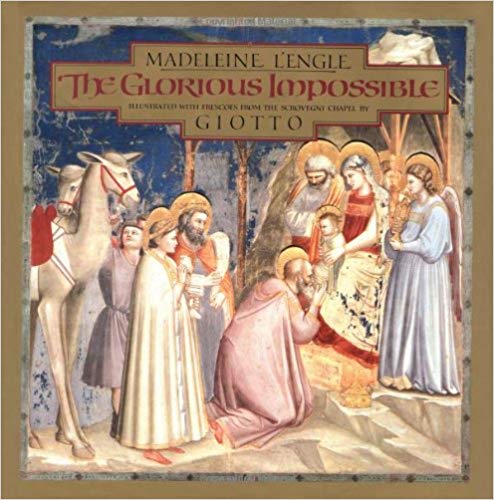 The Glorious Impossible by Madeleine L’Engle. This book, with its wonderful illustrations of frescoes by Giotto is a magnificent book to reflect on at any season of the year but particularly at Christmas. Madeleine’s commentary adds a richness to the book that I appreciate rereading every year. It takes us all the way through the New Testament from the coming of Gabriel to Mary to to Pentecost.
The Glorious Impossible by Madeleine L’Engle. This book, with its wonderful illustrations of frescoes by Giotto is a magnificent book to reflect on at any season of the year but particularly at Christmas. Madeleine’s commentary adds a richness to the book that I appreciate rereading every year. It takes us all the way through the New Testament from the coming of Gabriel to Mary to to Pentecost.
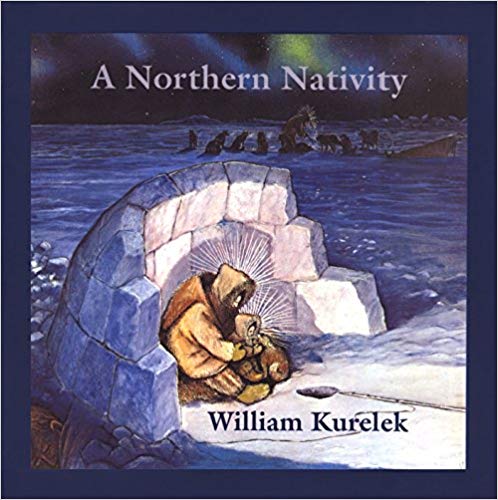 A Northern Nativity by Willian Kurelek. I love the way Kurelek depicts the Holy Family as Eskimos and First Nations people then follows the story across the frontiers of Canada in the early 1900s which was his childhood. A beautiful heartwarming and informative perspective.
A Northern Nativity by Willian Kurelek. I love the way Kurelek depicts the Holy Family as Eskimos and First Nations people then follows the story across the frontiers of Canada in the early 1900s which was his childhood. A beautiful heartwarming and informative perspective.
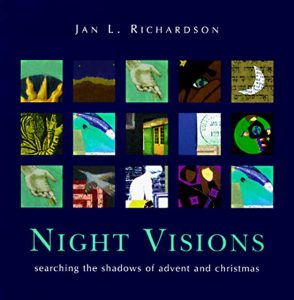 Night Visions: Searching The Shadows of Advent and Christmas by Jan Richardson I love Jan Richardson’s images and this one of Advent is stunning
Night Visions: Searching The Shadows of Advent and Christmas by Jan Richardson I love Jan Richardson’s images and this one of Advent is stunning
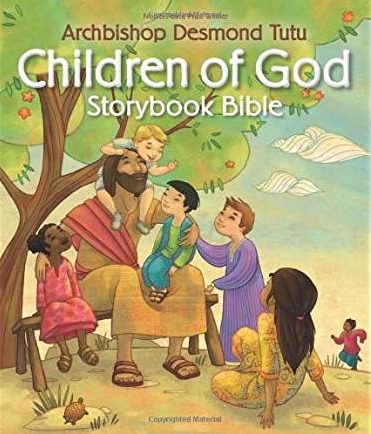 Children of God Storybook Bible by Archbishop Desmond Tutu. This is my most recent acquisition. Desmond Tutu recruited artists from around the world to depict stories from both Old and New Testament. Both beautifully written and beautifully illustrated.
Children of God Storybook Bible by Archbishop Desmond Tutu. This is my most recent acquisition. Desmond Tutu recruited artists from around the world to depict stories from both Old and New Testament. Both beautifully written and beautifully illustrated.
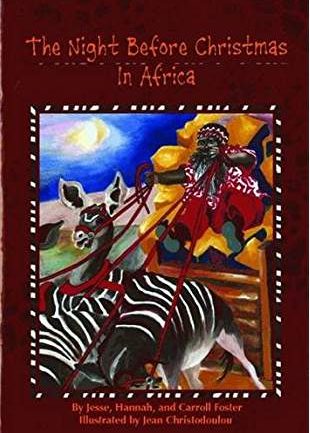 The Night Before Christmas in Africa by Jesse Foster, Hannah Foster and Carroll Foster. I have not read this (it is on my wish list for next year, but love the look of the story and the illustrations. Maybe it is because I too grew up with Christmas in summer and I couldn’t find a good Australian Christmas story that I thought was worth adding to this list.
The Night Before Christmas in Africa by Jesse Foster, Hannah Foster and Carroll Foster. I have not read this (it is on my wish list for next year, but love the look of the story and the illustrations. Maybe it is because I too grew up with Christmas in summer and I couldn’t find a good Australian Christmas story that I thought was worth adding to this list.
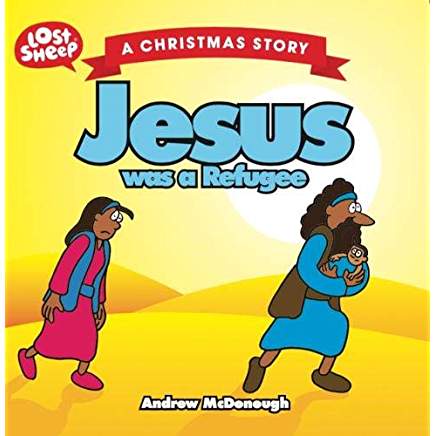 Jesus Was A Refugee by Andrew McDonough. Again I have not read this but it was recommended by Godspace author Keren Dibbens-Wyatt. “vivid and visual storytelling takes us beyond the joy of the Christmas story to the danger and disorientation of Jesus’ early years. It reminds us of the realities which refugees continue to experience in our world. It should be told alongside the traditional Nativity each year.” (from Amazon review. McDonough is an Australian which means this must be added it to my wishlist too!
Jesus Was A Refugee by Andrew McDonough. Again I have not read this but it was recommended by Godspace author Keren Dibbens-Wyatt. “vivid and visual storytelling takes us beyond the joy of the Christmas story to the danger and disorientation of Jesus’ early years. It reminds us of the realities which refugees continue to experience in our world. It should be told alongside the traditional Nativity each year.” (from Amazon review. McDonough is an Australian which means this must be added it to my wishlist too!
 The Nativity by Julie Vivas This was recommended by my Facebook friend Taeler Morgan. I have not read it but she says it is one of her favorites.
The Nativity by Julie Vivas This was recommended by my Facebook friend Taeler Morgan. I have not read it but she says it is one of her favorites.
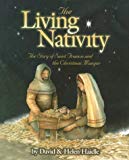 The Living Nativity by David and Helen Haidle. Another that I have not read but recommended by Jane Bartlett-Hessdorfer. It certainly seems to be worth adding to my list.
The Living Nativity by David and Helen Haidle. Another that I have not read but recommended by Jane Bartlett-Hessdorfer. It certainly seems to be worth adding to my list.
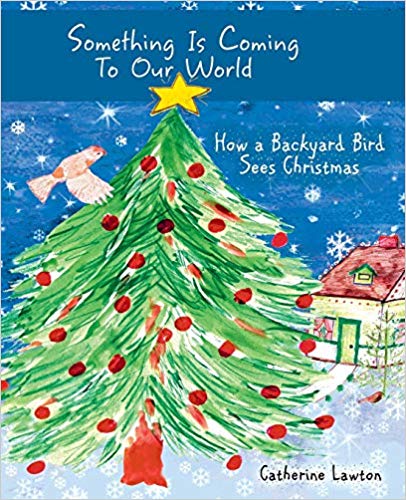 Something is Coming to Our World: How A Backyard Bird Sees Christmas recommended by the author Cathy Lawton. She says it combines creation care, wonder in nature and the Nativity story. The description says “For children and for adults who want to be more child-at-heart and wonder-filled during Advent and Christmas.” which is enough to get me hooked.
Something is Coming to Our World: How A Backyard Bird Sees Christmas recommended by the author Cathy Lawton. She says it combines creation care, wonder in nature and the Nativity story. The description says “For children and for adults who want to be more child-at-heart and wonder-filled during Advent and Christmas.” which is enough to get me hooked.
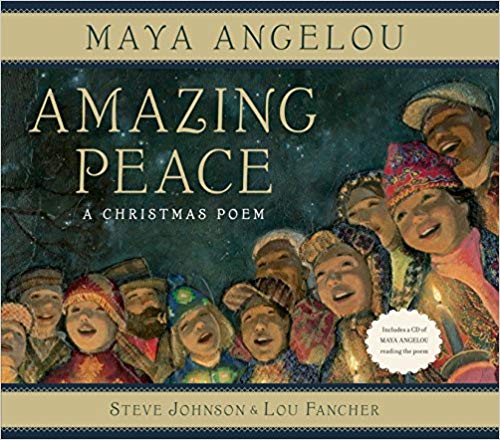 Amazing Peace by Maya Angelou.I fell in love with this one when I read the description and because Maya Angelou wrote it, but have not read it. I have added it to my wish list. “Angelou’s beautiful, moving, and beloved poem, which she first read at the 2005 White House tree-lighting ceremony, now comes alive as a fully illustrated children’s book, celebrating the promise of peace in the holiday season. In this simple story, a family joins with their community—rich and poor, black and white, Christian, Muslim, and Jew—to celebrate the holidays.”
Amazing Peace by Maya Angelou.I fell in love with this one when I read the description and because Maya Angelou wrote it, but have not read it. I have added it to my wish list. “Angelou’s beautiful, moving, and beloved poem, which she first read at the 2005 White House tree-lighting ceremony, now comes alive as a fully illustrated children’s book, celebrating the promise of peace in the holiday season. In this simple story, a family joins with their community—rich and poor, black and white, Christian, Muslim, and Jew—to celebrate the holidays.”
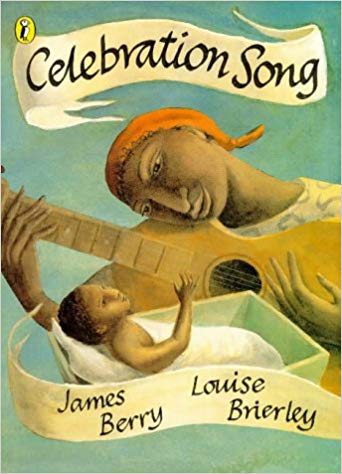 Celebration Song: A Poem by James Berry. This one is written from a Caribbean perspective and having worked in Jamaica several times it intrigued me and brought back memories of the wonderful music and art of that country. I can tell you my wish list just gets longer and longer.
Celebration Song: A Poem by James Berry. This one is written from a Caribbean perspective and having worked in Jamaica several times it intrigued me and brought back memories of the wonderful music and art of that country. I can tell you my wish list just gets longer and longer.
So what have I left off the list – what are your favorite images of the Christmas story? Which culture do they come from and why do they resonate with you?
As an Amazon Associate I earn a small amount from qualifying book purchases.
by Christine Sine
For the Celts songs, poems and epic sagas were an intrinsic part of their everyday life. They carried deep spiritual meanings and sometimes encouragement into the reality and often harshness of life.
This quote from my readings in Celtic Advent a couple of days ago has really resonated in my mind this week. David Cole goes on to remind us that
In Luke 1 we find Mary using this same form of expression when she is with Elizabeth. She glorifies God with song because of who God is, what God has done within her and what God will do through her. This song, known as the Magnificat, is Mary’s expression of praise to God in the way which seems, both from Hebraic and Celtic/AngloSaxon culture to be a most natural way to express our innermost senses and feelings.
As I read David’s words I realized that it was time to set up my sacred space for Advent and Christmas so pulled out this beautiful canvas photo of the Magnificat given to me by my good friend Tom Balke. He took the photo on a visit to maize a few years ago,
As I gazed at the photo this morning several images came to mind.
- First I was reminded of the many friends and relatives who are expecting at this time. I visualized each of them and their babies and offered a prayer and a song of praise to God for them. As I did so I felt a special sense of connection not just to them but to Mary and Elizabeth and their own unborn babies whom we remember at this time. I felt the joy of God rejoicing not just at the coming of these babies but of all the babies in our world.
- Second I was reminded of all the songs and poems that are within me. Some of them have already been birthed and shared on this blog, others are still growing within the womb of my soul, that quiet and sometimes dark place where I feel embraced by the comforting presence of God which makes it possible for me to give birth at the right season.
I was also reminded of this beautiful icon I found several years ago (but have never been able to trace down since). This image too speaks to me of the wonder of this season of Advent (already started for those of us who are celebrating the 40 days of Celtic Advent. It speaks not only of the hope and promise of the babies growing in both Elizabeth’s and Mary’s wombs but of the hope and promise of what God is growing within all of us.

Icon Mary and Elizabeth – source unknown
What Is You Response?
Take a few minutes to meditate on one of these images of Mary and Elizabeth.
Are there women that you know who are pregnant at this season? What are the hopes and promises that come to you as you pray for them? Perhaps you would like to copy this image as I did this morning and send it to them to let them know you are praying for them and their unborn child or children. Share with them the joy you are feeling
Think about Mary and Elizabeth and the children in their wombs. Look at the Taize image and focus on the chidden in Mary and Elizabeth. Read through the Magnificat which in The Message begins I am bursting with God-news. As you meditate on them and their unborn children today, what is the hope and promise, the God-news, that rejoices your heart as Mary’s heart rejoices in this song ?
What are the unborn prayers, songs and creative work that you sense is growing within you but is still to be birthed? All of us have unborn hopes for the future, creative seeds that have been planted within us but are still to be born. Many of them are inspired by the Spirit of God. Think about those seeds you know have been planted. Let your soul (and maybe your body) sing and dance for joy at what God has planted and will one day give birth to in you.
Is there another response God is asking of you at this time? Pull out your journal and write it down or respond with a song, a prayer or by creating an image.
Note: As an Amazon Associate I earn a small amount from qualifying book purchases – this helps us keep the blog as a top notch resource center.
Cyber Monday Sale – Free & Reduced Products on Godspace!
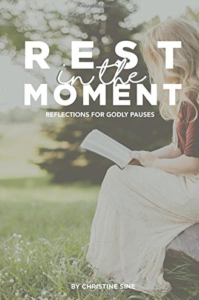 Digital Download of Rest in the Moment – 9.99, $6.99
Digital Download of Rest in the Moment – 9.99, $6.99
A PDF downloadable version of the book: Rest in the Moment. The twelve meditations in this beautiful full color book are designed to provide moments of refreshment throughout the day or week. The blending together of prayers, reflections, questions and photos invite us to pause, reset and refresh ourselves. Rest is such an important part of the rhythm of our lives, not just a weekly rest of Sabbath, but pauses of rest throughout the day to reset our focus and renew our connections to God. Even my fitbit tells me that I should relax for 2-3 minutes at regular intervals. We all need times when we pause for refreshment and renewal. Just as the night calls us to rest after a busy day and the winter calls us to rest after busy seasons of planting growth and harvest, so too does God beckon us to rest after hours of busy work.
3 Set Bundle of Prayer Cards – 25.99, $19.99
This bundle includes one set of each: Pause for the Day, Celtic Prayer Cards and Prayers for the Day Prayer Cards.
 1 Set of Pause for the Day Prayer Cards – 9.99, $8.99
1 Set of Pause for the Day Prayer Cards – 9.99, $8.99
Digital Download of Pause for the Day Prayer Cards – 4.99, $3.99
3 Sets of Pause for the Day – 25.99, $19.99
This set contains 3 morning, 3 evening and 4 prayers to encourage you to pause for prayer during the day. Each card has a short reflection on the back. These prayers are specifically designed to help you pause and slow down at intervals throughout the day. They can be used for individual times of meditation, to begin a time of group prayer, or for spiritual direction, counseling and even for grief counseling. We hope you will enjoy them and share them with your friends.
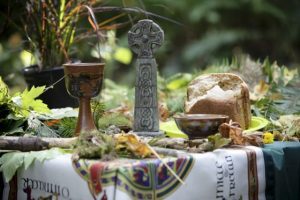 1 Set of Celtic Prayer Cards – 9.99, $8.99
1 Set of Celtic Prayer Cards – 9.99, $8.99
Download of Celtic Prayer Cards – 4.99, $3.99
3 Sets of Celtic Prayer Cards – 25.99, $19.99
Each set contains 10 prayers inspired by ancient Celtic saints like Patrick and Columba or by contemporary Celtic writers like John O’Donohue. A short reflection on the back of each card will introduce you to the Celtic Christian tradition. These cards can be used by individuals for daily meditation or by groups.
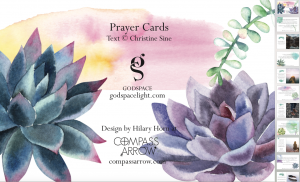 1 Set of Prayers for the Day – 9.99, $8.99
1 Set of Prayers for the Day – 9.99, $8.99
Digital Download of Prayers for the Day – 4.99, $3.99
3 Sets of Prayers for the Day – 25.99, $19.99
This set contains 10 general prayers that can be used as daily prompts or to encourage you to pause at different times of the day. Each card has a short reflection on the back and a succulent artistic theme.
FREE RESOURCES
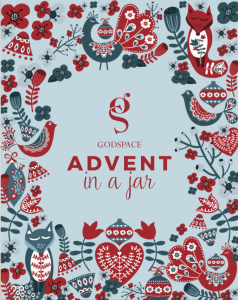 Advent in a Jar – Free Download!
Advent in a Jar – Free Download!
This is a fun activity to do with kids that provides a context in which to talk to them about Advent and the coming of Christ. Also great for adults! This is a downloadable packet that will walk you through the steps of creating your own advent jar and printable “sticks” to cut out and use that have a variety of activities on them for your family to enjoy as you prepare for the nativity of Jesus.
 Color Your Way Through Advent – Free Download!
Color Your Way Through Advent – Free Download!
by Christine Sine
The prayer above is one of the first that I ever wrote and I thought that I had lost it. Yesterday, as I was browsing through some old files, I found it again, and reading through it thought that it was very appropriate for this weekend – a good prayer to say goodbye to the old year of the liturgical calendar and hello to the new. On this weekend, we don’t just welcome Christ as King but we welcome the Holy Spirit who makes it possible for all of us to live as Christ did – a servant king who served rather than dominating, who walked amongst us, rather than sitting on a distant throne.
I hope that you enjoy it as much as I did.
More resources and prayers for Christ the King Sunday HERE
By Lilly Lewin
It’s Black Friday here in the States. I don’t know if this event takes place in other parts of the world, but here in America, Black Friday is one of the biggest shopping days of the year. It’s so big that some stores choose to open on Thursday night! That means opening at the end of a national holiday, Thanksgiving. We’ve just spent a day, supposedly being grateful for what we have, but then our culture encourages us to go out and spend money on things we think we need or we hope will bring us joy and happiness! The contrast of the two days is stark. I tend to avoid Black Friday altogether. It’s actually been a spiritual practice to avoid all shopping on Black Friday. It’s hard to do when all the ads on TV and in email are advertising the “great deals” that you don’t want to miss! There is so much intensity about shopping and getting stuff that it grieves my soul.
Black Friday has me thinking of grief in general. As I was getting ready to host my family for Thanksgiving, I was praying for all the families in California who lost their homes and couldn’t gather around their tables this year. I thought about everyone who lost family member and friends in the California fires. I thought about all people I know who are celebrating their first big holiday without a loved one, parent, spouse, or child. There is pain in the process of going about the day and all the memories of those people and traditions.
I’ve also been grieving the US vs THEM mentality in our country. Here in America, we are divided about so many things. We just had a major election and this did not make us more connected, but rather showed us how deeply we are entrenched on our sides. Hatred and lack of compassion seem to be seeping into all areas of our lives. We seem to have forgotten the golden rule of doing unto others as we would have them do unto us. We seem to abandon the greatest commandments to love God and love our neighbor.
How do we move forward? What can we do?
I think we need to acknowledge our grief in order to move forward!
We need to acknowledge our pain and allow God to begin to heal it.
Grief about the world, our country, and the pain and grief in our personal lives.
As we move into the season of Advent where we prepare our hearts for the coming of Jesus, let’s let the Light of Jesus shine into the darkness that we are carrying around with us.
Last week, I was at National Youth Workers Convention in St. Louis, MO. Over 4000 youth workers from all over the country gathered to learn and be encouraged in their ministries. As a part of the Soul Care Team, we created space for these folks to get their cups filled up, not just “get more information.” There are spiritual directors, the Prayer Chapel filled with Prayer Stations, and I curate the Sanctuary where we teach prayer practices like centering prayer, Benedictine spirituality, Sabbath, and pray the hours. My friend Beth Slevcove leads a workshop on grief. She has a great book on learning to grieve called Broken Hallelujahs: Learning to Grieve the Big and Small Losses of Life
check out the video preview here:
We also had a prayer station in the Chapel that allowed folks to process their grief. People wrote down the things that they were grieving and tied these prayers on to a grape vine.
Grief…
Blessed are Those who Mourn…
WRITE your Prayers of Grief and Regret on a piece of Muslin
And Tie it to the Grape Vine.
Give your loss, grief, despair to Jesus, The True Vine.
 What things are weighing you down?
What things are weighing you down?
What losses have you experienced this year?
What pain, grief, despair are you carrying with you right now?
What do you need to take time to grieve before Advent?
Make a List and give it to Jesus.
Perhaps you need to burn this list and let it go in that way.
Maybe you need to create a wailing wall of some kind and place your prayers of grief in the
Wall and give them to Jesus to hold and heal.
Maybe you just need to set aside some time to write in your journal or take a walk and talk to Jesus about your pain.
Take time this Black Friday to honor yourself and your grief.
Be still. Be Real. Jesus knows our hearts already and longs to bring us hope and comfort in our sorrow.
Let’s allow Jesus to prepare room in our hearts as we prepare for his incarnation.
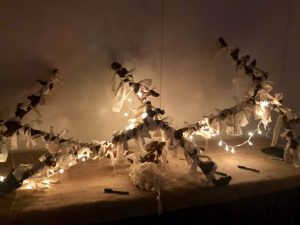
Sunday is Christ the King Sunday, the last Sunday the liturgical year. I must confess it is not a celebration that is very much on my radar screen and this year with it falling the week of American Thanksgiving, I have given it even less attention. I thought that this celebration must date from the Middle Ages, but discovered recently that Pope Pius XI added it in 1925. He intended it as a day to celebrate and remember Christ’s kingship over all creation, as well as to remind us that all humankind must submit to Christ’s rule.
As you can imagine, this celebration, especially in recent years, been a somewhat controversial day among those Christians who consider the language of kingship outdated or oppressive. For many, the images of kings and kingdoms conjure up thoughts of tyrants. But the kingship of Jesus takes on a very different form than does the kingship of earthly rulers. He came as a vulnerable infant and carried that vulnerability into his kingship of servanthood as we hear in this, my favourite “kingship” song.
Jesus comes to us not as a great conquering military leader who oppresses and abuses the conquered. Rather, he comes as a servant king, the Prince of Peace, the One whose reign proclaims peace, justice, liberation, and above all, service. Jesus turned the whole concept of lordship and kingship on its head:
You know that those who are recognized as rulers over the Gentiles lord it over them, and their great ones make their authority over them felt. But it shall not be so among you. Rather, whoever wishes to become great among you will be your servant; whoever wishes to be first among you will be the slave of all. For the Son of Man did not come to be served, but to serve, and to give his life as a ransom for many. (Mark 10:42-45, NAB).
Images of God, as Lord and King seem foreign in a democratic, individualistic society. But our all-powerful God, is also all-loving, and all-merciful. God’s heart aches to once more be in a loving relationship with his creatures. This is what Christ’s kingship is all about. We must submit to Jesus as our Lord and King, but it is a submission that paradoxically brings with it liberation, freedom from sin and a life of wholeness for us, for others and for God’s world.
I love this powerful image of Jesus as King and the kingdom of God as a place of hope that Foy Vance gives us here:
Jesus knew the popular images of kings and lords and redefined them. In God’s resurrection world, in order to be a ruler of all, Jesus must become a servant of all. Jesus demonstrated this servanthood in his life and miracles. Even the Incarnation is an example of this: God the Son, King of all creation, humbled himself to become human, even sharing the ultimate fate of his captive subjects: death.
Interestingly, most references to Jesus as king occur during the Passion story. The symbol of Christ’s kingship is not a crown but a cross. The Son of God became human and died a horrible death on the cross to release his subjects from captivity. The One who is the true king of our world made this ultimate sacrifice out of his deep and abiding love for the world, a world constantly in rebellion against him. Christ’s kingship is not like a king with a jewel-encrusted crown in purple finery on a gold throne wielding an oppressive rod of iron. Rather, he is the crucified God with a crown of thorns hanging half naked on a cross of shame to set us free from our bondage.
No collection for Christ the King Sunday is complete without this inspiring description of Christ the King of Kings by SM Lockridge.
Here is a prayer that I wrote a couple of years ago for Christ the King Sunday:
Let us praise Jesus Christ our king
for the wonderful things he has done.
He sends out his word to heal us.
He satisfies the thirsty with the water of life.
He fills the hungry with the abundance of his kingdom.
Let us praise Jesus, redeemer and renewer of all things.
May we always trust in his goodness and love,
And have faith in his grace and mercy,
May we always believe he cares about justice and righteousness,
And draw our life from his eternal purposes.
Let us praise Jesus Christ our king and saviour,
May we be filled with the hope and promise of his coming,
And give our lives to follow him.
May we be gripped by his kingdom ways,
And walk with assurance and trust into his grace and peace.
Other Resources for Christ the King Sunday
- Prayers for Christ the King Sunday here
- Service of Worship for Christ the King Sunday
- Other resources for Christ the King Sunday
And after all that serious stuff you might like a little light liturgical dancing for Christ the King Sunday:
As an Amazon Associate, I receive a small amount for purchases made through appropriate links.
Thank you for supporting Godspace in this way.
When referencing or quoting Godspace Light, please be sure to include the Author (Christine Sine unless otherwise noted), the Title of the article or resource, the Source link where appropriate, and ©Godspacelight.com. Thank you!

